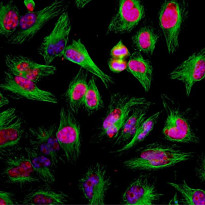ARG11112
anti-Ki-67 antibody
anti-Ki-67 antibody for ICC/IF,Western blot and Human,Mouse,Rat
Overview
| Product Description | Chicken Polyclonal antibody recognizes Ki-67 |
|---|---|
| Tested Reactivity | Hu, Ms, Rat |
| Tested Application | ICC/IF, WB |
| Host | Chicken |
| Clonality | Polyclonal |
| Isotype | IgY |
| Target Name | Ki-67 |
| Antigen Species | Human |
| Immunogen | Mixture of two recombinant Human Ki-67 constructs: aa. 1-300 and aa. 1111-1490. |
| Conjugation | Un-conjugated |
| Alternate Names | Antigen KI-67; MIB-; KIA; MIB-1; PPP1R105 |
Application Instructions
| Application Suggestion |
|
||||||
|---|---|---|---|---|---|---|---|
| Application Note | * The dilutions indicate recommended starting dilutions and the optimal dilutions or concentrations should be determined by the scientist. |
Properties
| Form | Liquid |
|---|---|
| Buffer | PBS and 5 mM Sodium azide. |
| Preservative | 5 mM Sodium azide |
| Storage Instruction | For continuous use, store undiluted antibody at 2-8°C for up to a week. For long-term storage, aliquot and store at -20°C or below. Storage in frost free freezers is not recommended. Avoid repeated freeze/thaw cycles. Suggest spin the vial prior to opening. The antibody solution should be gently mixed before use. |
| Note | For laboratory research only, not for drug, diagnostic or other use. |
Bioinformation
| Database Links | |
|---|---|
| Gene Symbol | MKI67 |
| Gene Full Name | marker of proliferation Ki-67 |
| Background | This gene encodes a nuclear protein that is associated with and may be necessary for cellular proliferation. Alternatively spliced transcript variants have been described. A related pseudogene exists on chromosome X. [provided by RefSeq, Mar 2009] |
| Function | Required to maintain individual mitotic chromosomes dispersed in the cytoplasm following nuclear envelope disassembly (PubMed:27362226). Associates with the surface of the mitotic chromosome, the perichromosomal layer, and covers a substantial fraction of the chromosome surface (PubMed:27362226). Prevents chromosomes from collapsing into a single chromatin mass by forming a steric and electrostatic charge barrier: the protein has a high net electrical charge and acts as a surfactant, dispersing chromosomes and enabling independent chromosome motility (PubMed:27362226). Binds DNA, with a preference for supercoiled DNA and AT-rich DNA (PubMed:10878551). Does not contribute to the internal structure of mitotic chromosomes (By similarity). May play a role in chromatin organization (PubMed:24867636). It is however unclear whether it plays a direct role in chromatin organization or whether it is an indirect consequence of its function in maintaining mitotic chromosomes dispersed (Probable). [UniProt] |
| Cellular Localization | Chromosome. Nucleus. Nucleus, nucleolus. Note=Associates with the surface of the mitotic chromosome, the perichromosomal layer, and covers a substantial fraction of the mitotic chromosome surface (PubMed:27362226). Associates with satellite DNA in G1 phase (PubMed:9510506). Binds tightly to chromatin in interphase, chromatin-binding decreases in mitosis when it associates with the surface of the condensed chromosomes (PubMed:15896774, PubMed:22002106). [UniProt] |
| Calculated MW | 359 kDa |
| PTM | Phosphorylated. Hyperphosphorylated in mitosis (PubMed:10502411, PubMed:10653604). Hyperphosphorylated form does not bind DNA. [UniProt] |
Images (2) Click the Picture to Zoom In
-
ARG11112 anti-Ki-67 antibody ICC/IF image
Immunofluorescence: HeLa cells stained with ARG11112 anti-Ki-67 antibody (red) at 1:2000 dilution, and co-stained with anti-beta Tubulin antibody (green) at 1:5000 dilution. DAPI (blue) for nuclear staining.
-
ARG11112 anti-Ki-67 antibody WB image
Western blot: Rapidly dividing HeLa and HEK293 cell cultures. Cell lysates were stained with ARG11112 anti-Ki-67 antibody at 1:5000 dilution.
Strong double bands above 250 kDa correspond to the two major Ki-67 isoforms of molecular weight 345 kDa and 395 kDa. Since Ki-67 is a rather unstable snd short half life protein multiple proteolytic fragments of the two isoforms are also detected on the blot.







